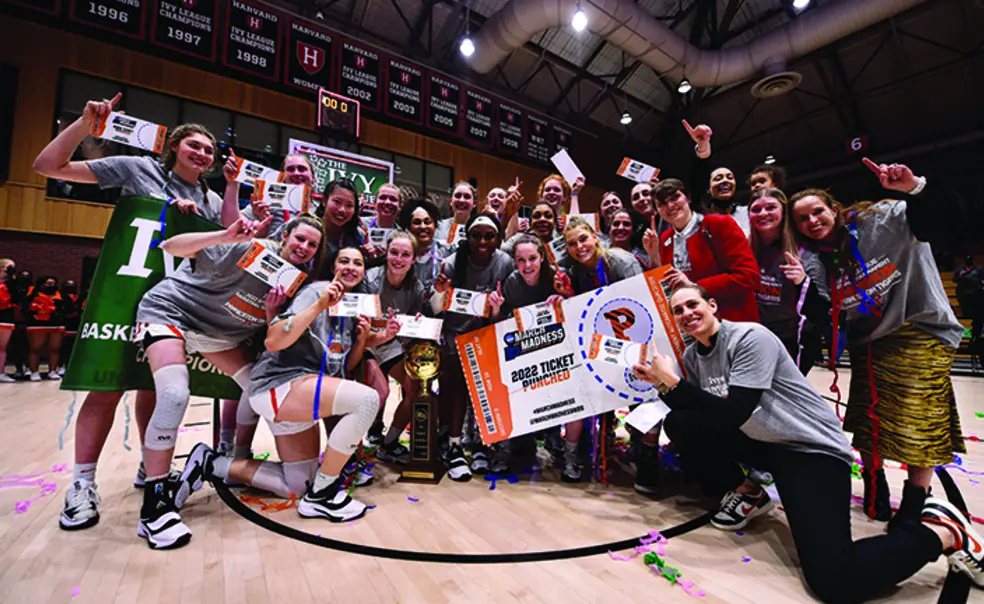Still Evolving, Ivy Tournament Comes to Jadwin for the First Time
As of Feb. 15, both Princeton teams were tied for first place in the league
Last March, the Princeton women’s basketball team found itself in its closest Ivy League game at the worst possible time. Though the Tigers went 14-0 in the regular season, they still had to earn an NCAA Tournament bid in a single-elimination conference tournament, where No. 4-seed Harvard hung with them in front of a home crowd in a tense semifinal. The Crimson pulled within one point in the final minute, but Princeton sealed the game with timely defense and free throws before beating Columbia in the next day’s final.
“It’s really hard to beat a team three times, so we got their best game,” said Julia Cunningham ’23, a captain on this year’s Princeton team. “All of us knew what was at stake and that we needed to win that game to get to the final.”
The game encapsulated the pros and cons of a conference tournament, which Ancient Eight fans have debated for decades (before 2017, Ivy League basketball stood out in awarding its NCAA berths to the regular-season champion). Tournaments generate excitement and exposure by creating games with massive stakes at a time when college basketball is in the spotlight. Yet they also make it less likely that the league’s best team will move on to March Madness. The Princeton women went on to reach the second round of the NCAA Tournament, but they never would have gotten that opportunity had they faltered against Harvard — unless they received an at-large bid, which is very rare for teams outside of power conferences.
On balance, however, the postseason tournament has been well-received throughout the league — and the idea is spreading. New tournaments were recently instituted or approved for women’s volleyball, field hockey, and men’s and women’s soccer. The fifth “Ivy Madness” basketball tournament (COVID-19 caused cancellations in 2020 and 2021) will be held at Jadwin Gymnasium March 10-12. As of Feb. 15, both Princeton teams were tied for first place in the league and on track to qualify for the four-team affair.
From day one, athletes and coaches have praised the added excitement of chasing playoff spots and participating in the tournament. “Overall, I think this is a good thing for the student-athlete experience,” men’s basketball coach Mitch Henderson ’98 said.
Ivy League executive director Robin Harris said that even though they run concurrently with higher-profile games in power conferences, the tournaments have put Ivy teams in the national spotlight. “When I’m sitting at the championship game and I’m getting text messages from other [conference] commissioners and the NCAA president who are watching the game — and I also know the men’s and women’s selection committees are watching the games as they’re meeting to select the teams for the tournament — that’s just amazing exposure for Ivy League basketball,” Harris said.
The league made some unique choices for its format. By inviting just four teams, it limits the time demands on athletes and adds an intriguing playoff race to the regular season. And it’s one of the few conferences whose men’s and women’s tournaments occur at the same time and place, making it easier for fans and reporters to attend both. “There’s a lot of media there and emotions are always high,” Cunningham said. “It’s always a really exciting event, it’s very well-run, and we’re excited to have it at Jadwin this year.”
With the tournament still young, Harris said the league collects feedback from coaches and athletes each year and considers potential adjustments to the format. After the first two tournaments were held at the Palestra on Penn’s campus, it established a rotation to bring the event to the other seven Ivy campuses. And when holding both tournaments on Saturday and Sunday proved too tight, it moved the women’s schedule up a day last year.
Ivy fans can still enjoy postseason debates — just no longer if a tournament should be held, but how. One potential topic is whether the regular-season champion should have more of an advantage. Some conferences give the top seed home-court advantage or byes, but the Ivy tournament is a flat four-team bracket at a predetermined site. “There’s very little protection for the 1-seed,” Henderson said. “I know that our athletic directors are looking closely at this, and we want to make sure we’re giving the best chance to send our best team to the NCAAs.”
Another potential change would be expanding the field to more teams, giving more players the opportunity to participate: Dartmouth, Columbia, and Brown have never made the men’s tournament, and Dartmouth has never qualified for the women’s. “Given how close the Ivy League has been in the last 5-10 years, and there have been multiple ties already for fourth place, I wish it would be expanded,” said Noah Savage ’08, a former Princeton basketball team captain who broadcasts Ivy League games for the ESPN networks. “I think that most coaches are in favor of an eight-team tournament — you get more participation, more games, and everybody gets to experience basketball in March, which is really exciting.”
However, every issue has trade-offs. For example, adding more teams would diminish the excitement of the regular season, and it might become too difficult to keep the men’s and women’s events at the same site.
“I think [the four-team structure] has been very successful and also consistent with our approach generally to athletics in making sure that the impact on the student-athletes’ time allows them to be students,” Harris said. “While there are certainly coaches that would like to see all eight teams be able to participate, I think this has worked so incredibly well, I’m not hearing a groundswell for that changing.”













No responses yet